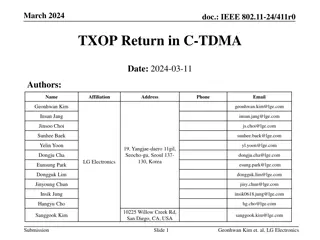
Return-to-libc Attacks and Countermeasures
Explore the concept of Return-to-libc attacks, the non-executable stack countermeasure, defeating the countermeasure, tasks involved in the attack, and strategies to launch an effective defense. Learn about running shellcode in a C program, exploiting vulnerabilities, and more.
Download Presentation

Please find below an Image/Link to download the presentation.
The content on the website is provided AS IS for your information and personal use only. It may not be sold, licensed, or shared on other websites without obtaining consent from the author. If you encounter any issues during the download, it is possible that the publisher has removed the file from their server.
You are allowed to download the files provided on this website for personal or commercial use, subject to the condition that they are used lawfully. All files are the property of their respective owners.
The content on the website is provided AS IS for your information and personal use only. It may not be sold, licensed, or shared on other websites without obtaining consent from the author.
E N D
Presentation Transcript
Outline Non-executable Stack countermeasure How to defeat the countermeasure Tasks involved in the attack Function Prologue and Epilogue Launching attack
Non-executable Stack Running shellcode in C program Calls shellcode
Non-executable Stack With executable stack With non-executable stack
How to Defeat This Countermeasure Jump to existing code: e.g. libc library. Function: system(cmd): cmd argument is a command which gets executed.
Environment Setup This code has potential buffer overflow problem in vul_func() Buffer overflow problem
Environment Setup Non executable stack countermeasure is switched on, StackGuard protection is switched off and address randomization is turned off. Root owned Set-UID program.
Overview of the Attack Task A : Find address of system(). To overwrite return address with system() s address. Task B : Find address of the /bin/sh string. To run command /bin/sh from system() Task C : Construct arguments for system() To find location in the stack to place /bin/sh address (argument for system())
Task A : To Find system()s Address. Debug the vulnerable program using gdb Using p (print) command, print address of system() and exit().
Task B : To Find /bin/sh String Address Export an environment variable called MYSHELL with value /bin/sh . MYSHELL is passed to the vulnerable program as an environment variable, which is stored on the stack. We can find its address.
Task B : To Find /bin/sh String Address Export MYSHELL environment variable and execute the code. Code to display address of environment variable
Task B : Some Considerations Address of MYSHELL environment variable is sensitive to the length of the program name. If the program name is changed from env55 to env77, we get a different address.
Task C : Argument for system() Arguments are accessed with respect to ebp. Argument for system() needs to be on the stack. Need to know where exactly ebp is after we have returned to system(), so we can put the argument at ebp + 8. Frame for the system() function
Task C : Argument for system() Function Prologue esp : Stack pointer ebp : Frame Pointer
Task C : Argument for system() Function Epilogue esp : Stack pointer ebp : Frame Pointer
Function Prologue and Epilogue example 1 2 Function prologue 1 Function epilogue 2 8(%ebp) %ebp + 8
How to Find system()s Argument Address? Change ebp and esp Modified Return Address Use of system() s argument vul_func() epilogue system() prologue In order to find the system() argument, we need to understand how the ebp and esp registers change with the function calls. Between the time when return address is modified and system argument is used, vul_func() returns and system() prologue begins.
Flow Chart to understand system() argument Return address is changed to system() address. ebp is replaced by esp after vul_func() epilogue Jump to system() /bin/sh is stored in ebp+8 ebp is set to current value of esp system() prologue is executed Check the memory map ebp + 4 is treated as return address of system(). We can put exit() address so that on system() return exit() is called and the program doesn t crash.
Malicious Code ebp + 12 ebp + 8 ebp + 4
Launch the attack Execute the exploit code and then the vulnerable code
Return-Oriented Programming In the return-to-libc attack, we can only chain two functions together The technique can be generalized: Chain many functions together Chain blocks of code together The generalized technique is called Return-Oriented Programming (ROP)
Chaining Function Calls with Arguments Idea: skipping function prologue
Chaining Function Calls with Arguments Idea: using leave and ret
Chaining Function Calls with Zero in the Argument Idea: using a function call to dynamically change argument to zero on the stack Sequence of function calls (T is the address of the zero): use 4 sprint() to change setuid() s argument to zero, before the setuid function is invoked. Invoke setuid(0) before invoking system( /bin/sh ) can defeat the privilege- dropping countermeasure implemented by shell programs.
Summary The Non-executable-stack mechanism can be bypassed To conduct the attack, we need to understand low-level details about function invocation The technique can be further generalized to Return Oriented Programming (ROP)






















